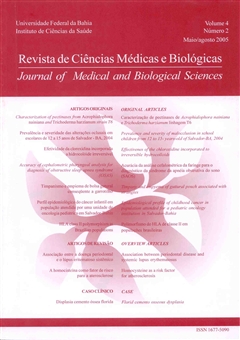Prevalence and severity of malocclusion in schoolchildren from 12 to 15- yearsold of Salvador-BA, 2004
DOI:
https://doi.org/10.9771/cmbio.v4i2.4181Keywords:
malocclusion- epidemiology, public health dentistry.Abstract
Although an evident perception of growth of the demand for orthodontic treatment in the society contemporary, there are few epidemiologic data on this health problem. The aim of this work was to determine the prevalence and severity of maloocclusois in schoolchildren of 12 the 15 years of Salvador-BA, through a survey of population base using as indicating the classification of Angle, the Dental Aesthetic Index (DAI) and the register of dental and face morphologic problems. The 2100 adolescents from 12 to 15-years-old, chosen through a random representative sample for the city of Salvador-BA had been examined by six examiners previously calibrated. Amongst the adolescents, 899 were of the boys, 1211 of girls, and the predominant ethnic group was mulatto (70,76%). The average of DAI in this study was of 26.06 with a standard deviation of 7.67. According to categories of treatment necessity had been found the following values: "none" - 54.31%, "elective treatment" - 23.22%, "highly desirable treatment" - 11.33% and "mandatory treatment" - 11.14%. In accordance with the classification of Angle, the most found malocclusion was Class I (39.67%), followed of Class III and II (23.55% and 19.00%) respectively. Moreover, the clinical morphologic with bigger occurrence in this population had been the central incisors deviation and overcross.Downloads
Download data is not yet available.
Downloads
Published
2005-06-11
How to Cite
Lopes, L. S., & Cangussu, M. C. T. (2005). Prevalence and severity of malocclusion in schoolchildren from 12 to 15- yearsold of Salvador-BA, 2004. Journal of Medical and Biological Sciences, 4(2), 105–112. https://doi.org/10.9771/cmbio.v4i2.4181
Issue
Section
ORIGINAL ARTICLES
License
The Journal of Medical and Biological Sciences reserves all copyrights of published works, including translations, allowing, however, their subsequent reproduction as transcription, with proper citation of source, through the Creative Commons license. The periodical has free and free access.


